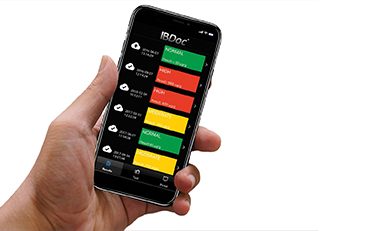- [email protected]
- +44 (0) 23 8048 3000
Point of Care Testing for Calprotectin / A doctor's experience
- User : Dr Sean Nugent
- Establishment: The Whitfield Clinic
- Resource: Quantum Blue
- Date: March 11, 2013
Dr Sean Nugent, Consultant Gastroenterologist,of The Whitfield Clinic, Waterford, Ireland, talks to us about his introduction of the Quantum Blue Calprotectin Test into his clinic.
Read more about Quantum BlueAlpha Labs: Can you describe your clinical service at the Whitfield Clinic?
Dr. Nugent: I run a full time private practice in Gastroenterology, upper and lower GI tract and liver investigations. I employ many technologies in my practice including H.Pylori breath testing, Methane testing and celiac screening and find the instant utility and generation of results helps my decision making.
Alpha Labs: What is your patient population and their clinical characteristics?
Dr. Nugent: Through my gastro clinic I see about 1,000 patients per year, 5-8% are new IBD patients and 10-20% are follow up IBD patients.
Alpha Labs: When did you first hear about calprotectin testing?
Dr. Nugent: In about 2000 when I was doing research at St. George’s Hospital, London, but it went off my radar until a few years ago when I became
more aware of its value and utility. However, calprotectin testing had not been readily available in a format to suit my practice. Send outs would take up to 3 weeks for a result and weren’t cost effective.Alpha Labs: What prompted you to look for a rapid quantitative calprotectin test?
Dr. Nugent: At the BSG in June 2012 I came across the Alpha Laboratories stand displaying the Quantum Blue® reader and realised the technology had improved and was now available in a near patient, rapid result format. This fitted in with other tests I use in my practice. My enthusiasm was so great that I wanted to take the reader from the exhibition stand!
Alpha Labs: How did you find setup of the Quantum Blue® assay?
Dr. Nugent: The assay protocol only requires very basic lab skills and I am very hands on with regard to near patient testing. The test cartridges are easy to use, reading of results is straightforward and also reliable. The extraction device simplifies the process and we have a system in place where the hospital assists with acquiring the sample. The device is very user-friendly. I can generate calprotectin results before the patient lab results are available and this assists with my clinical assessment.
Alpha Labs: What is your current application for the calprotectin test values?
Dr. Nugent: There are several different uses in a clinic setting. The calprotectin value will assist when discriminating between IBS and IBD. For a patient where there is a strong clinical suspicion of IBS and they meet the Rome III Criteria, whilst IBD is always at the back of my mind, I am not in a rush to scope patients that may just have IBS. The calprotectin results below 30μg/g reassure me and enable patient referral to a dietician at this stage. When the patients have elevated calprotectin values I can proceed with further investigation.
Secondly, for patients that I have already diagnosed with IBD, the calprotectin values add a whole new level of insight. For our IBD patients we operate an open door policy. Whenever they are unwell they can phone in and if symptoms are severe or persistent, they will be called in to assess their calprotectin values. These results guide me to the next step and allow earlier intervention. Normally we would have to wait for bloods or result of a Sigmoidoscopy. I usually run samples at the end of my clinic and it takes just 30 minutes. I can continue with other work as I wait for the results which are provided in 12 minutes.
Alpha Labs: Can you provide examples where a rapid result has been useful?
Dr. Nugent: I have been using Quantum Blue for 3-4 months now and suddenly I have a whole new index of activity to look at. There are situations where the values weren’t quite what I was expecting. One example is of a patient that wasn’t feeling right but had good stool frequency
and no blood. I ran the calprotectin test and the result came back >300μg/g. I questioned whether I had done something wrong but nothing from the investigation was evident. One month later she was back in my clinic with a relapse. Her calprotectin values had been elevated before the outward symptoms had developed. I may not have done anything different, but the calprotectin was able to predict relapse.Another example was with a patient I had diagnosed with Crohn’s disease 4 years ago. They had been doing really well for 3 years but then presented with right side pain and abdominal discomfort fitting the profile for gall stones. An ultrasound was all clear as was gastroscopy. Although there were no bowel symptoms I decided to check the calprotectin value. This came back >300ug/g, indicating that active inflammation was present. I repeated colonoscopy and investigated the terminal ileum – both of which were normal. I questioned whether the calprotectin was helping or misleading me. The answer came with a capsule video study that identified about forty aphthous ulcers in the terminal ileum, beyond the reach of a scope. This was like a shining light. The calprotectin had confirmed there was inflammation, generating further investigation. If it weren’t for the calprotectin I would have dismissed the symptoms. Happily the patient is now on therapy and doing really well.
Alpha Labs: How does the Quantum Blue calprotectin result impact on clinical decisions?
Dr. Nugent: The benefits are seen in the following instances
- IBS /IBD initial discrimination
- IBD general follow up of patients
- Predicting when patients are going to experience
- flare ups, useful insight
- Help in identifying areas of active inflammation that could have been missed, ensuring patients are not dismissed.
The availability of this test has altered my practice by aiding clinical decisions at a much earlier time point and thus benefiting patient care.
Alpha Labs: Do your patients know what calprotectin is and how it is used? Are they interested in their calprotectin values?
Dr. Nugent: Initially patients weren’t aware of this test. Some patients are very interested and want to know their value and follow up result. For some patients it has helped motivate them and requesting a sample is seen as less and less of a problem.
Alpha Labs: Can you see a role for the Quantum blue device in other settings?
Dr. Nugent: I think the Quantum Blue device for calprotecin is a “no brainer” for a secondary care setting. The benefits are immediate for both patient and consultant. I don’t know why colleagues are not using this routinely and universally it is of huge benefit in a clinic setting. G.P’s may be a bit more reluctant to employ this due to the steps involved. The broad utility of the calprotectin test in my practice assists with decisions and often leads to earlier intervention and ultimately better patient care.
Alpha Labs: As a user can you suggest any improvements to the Quantum Blue calprotectin device?
Dr. Nugent: Only that the operating software for the reader is quite basic, it needs more fields for recording of patient demographics for printable reports and archiving.




